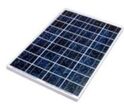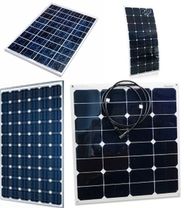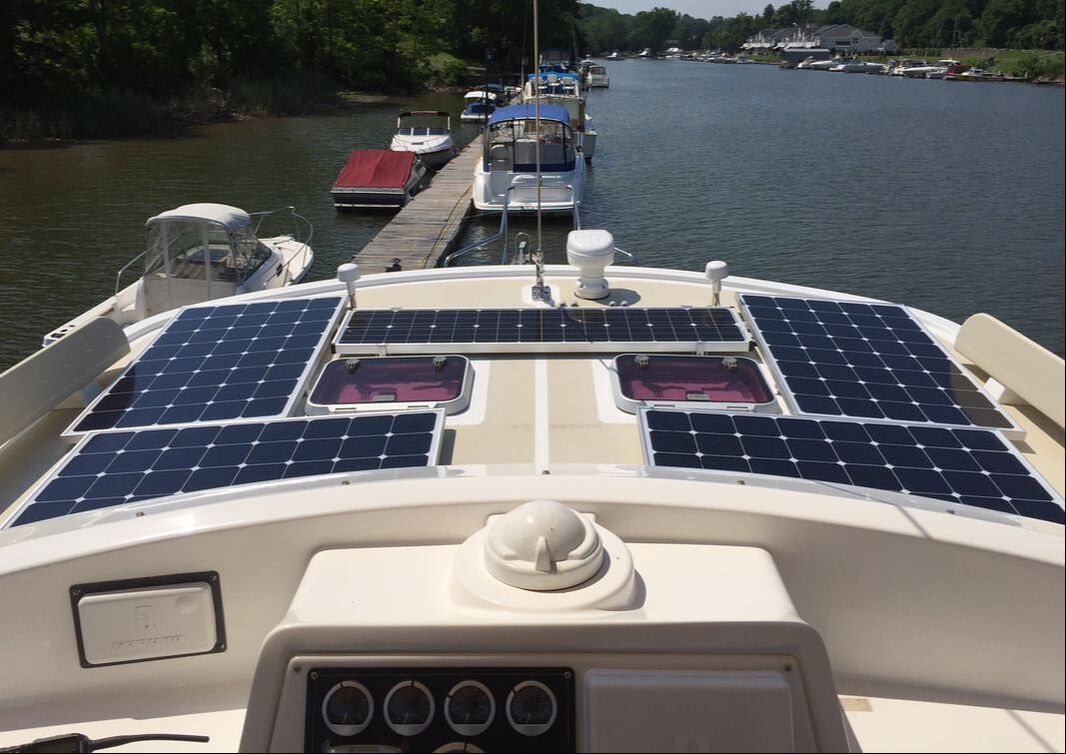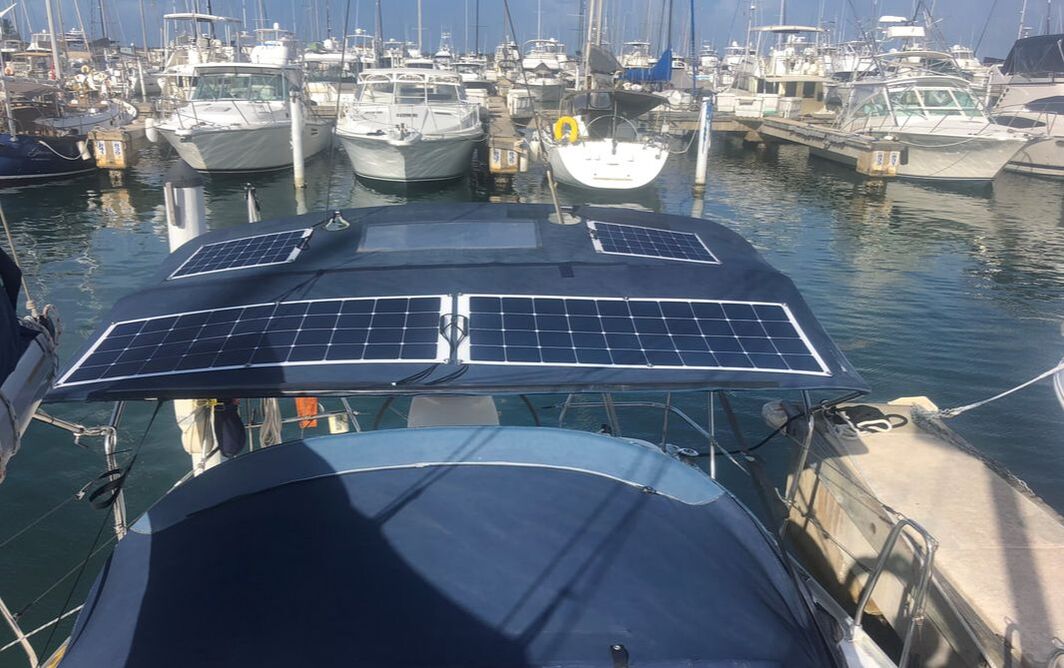|
High Performance CMPower Marine Solar Panel Specifications Summary
CMPower marine solar panels are available with the latest premium solar cells: SunPower, HJT, Perc
SunPower Maxeon Series
|
Our SunPower Maxeon Series solar panels are made with SunPower Maxeon Gen III solar cells which have the highest energy yield (power output) of any solar cell commercially available. SunPower Maxeon cell technology uses a back contact design which maximizes the sunlight energy available to each solar cell and enables a sunlight to electric conversion efficiency of up to 25.4%.
For a less expensive option, scroll down for our HJT and Perc line of panels, 25~% less cost, 1-3% less efficiency (24-25.4%+ vs 22.4-24.1%). Call any time for help or questions at 773-965-2546. |
Light walk-ons, walk-ons, flexibles
|
HJT & Perc Cell Series (~25% less cost, HJTs ~1.4% less efficient [25.4 vs 24%], Perc's 22.5% efficient)
SunPower Maxeon Shade Tolerant Series Created for Biminis ***** NEW *****
We also have these panels in stock, ask for drawings and stats:
- Semi-flexible 290 W, black background 1,132 mm x 1,266 mm (44.6” x 49.8”) Pre-installed VHB tape, 78 PERC cells (6 x 13) $1079 Link to drawing
- Semi-flexible 400 W, black background 1,127 mm x 1,728 mm (44.4” x 68.0”) Pre-installed VHB tape, Junction box in middle of panel, 108 PERC cells (6 x 18) $1279 Link to drawing
PERC (Passivated Emitter and Rear Contact) cells are about 2% less efficient than Sunpower cells and cost about 25% less. These modified conventional cells produce 6 to 12 percent more energy than conventional monocrystalline solar cells. Premium PERC solar cells have an extra layer within the back side of the cell. This allows some of the sun’s rays to reflect back into the solar cell, increasing the amount of energy produced resulting in a conversion efficiency of up to 22.5%. This enables us to provide the same high quality at a lower price per watt.
Click below to learn more about a specific solar panel type
Some Things to Know About Our Premium Solar Panels
- The key to a high performance, high quality marine solar panel that will last is the quality of the solar cells used in the panel. We use only the highest efficiency grade A+ solar cells.
- Our panels are built with premium SunPower's highest efficiency (A+ Grade, up to 25.4% efficient) monocrystalline back contact solar cells and HJT (24% efficient) and PERC high efficiency monocrystalline solar cells.
- Our solar panels have essential blocking and bypass diodes built in (to prevent power from flowing into shaded panels or from batteries into solar panels at night)
- Our solar panels have potted (filled with silicone) junction boxes to protect the electronics from environmental damage.
- Our rigid solar panels have strong anodized aluminum frames and marine grade sealants.
- Our flexible and semi-rigid solar panels average the same output per area as our rigid panels and are constructed with high quality ETFE laminates that won't deteriorate (turn milky) or delaminate from intense heat and UV exposure.
- Our solar panels have a 5 year warranty on all of our flexible panels, a 5 year warranty on our semi-rigid panels and a 7 year warranty on our rigid panels.
A Few Facts About Our Premium Marine PV Solar Panels

Panel Solar Cell Quality - Because boats (and vans, and RVs) have a relatively confined space, maximum power output per surface area is very important. The quality of the solar cells used in solar panels is a key factor in determining the panel output. Solar cells are passed under a standard light source and graded as to their output (1-10). Grades are grouped into classes. Class A (and A+) solar cells are grades 8-10, Class B solar cells are grades 4-7 and so on. Solar cell quality follows a bell curve; there are many more Class B solar cells than Class A. We at Custom Marine Products specify only the best Class A-9 (A+) solar cells for use in our panels which results in a panel efficiency of up to 25.4%. Less expensive Class B and C panels are often used on land based solar farms where space is not an issue, 16-20% efficiency usually. Though a bit more expensive, our customers have reported that our solar panels on occasion will outperform the performance rating on the panel label.
 Average 5 Sun Hours in a Day
Average 5 Sun Hours in a Day
High quality high performance solar cells will produce more power at various sun angles than lower quality solar cells; up to 30% more power. An important consideration in determining how much solar power you need is how many watt hours or amp hours of power you can expect to generate in a 24 hour period. Let's say you cruise in an area that receives an average of 5 hours of full sun a day. The average is computed based on the seasonal sun angle and the sun angle from morning through evening. A 100 watt solar panel with average efficiency solar cells may produce 100 watts x 5 hours or 500 watt hours of power in a day. At 13 volts that's about 38 amp hours in a day. A 100 watt panel with high efficiency solar cells will produce up to 30% more power in a 24 hour period or 100 watts x 6.5 effective hours or 650 watt hours of power in a day. At 13 volts, that's about 50 amp hours in a day. 38 amp hours vs. 50 amp hours in a day is significant on a boat (or van or RV). Add more panels in the mix, say 400 watts and we see 152 amp hours vs.200 amp hours, a difference of 48 amp hours. This simple analysis does not take into consideration the impact of clouds or shading both of which will make the disparity even greater. Clearly, the higher the quality of the solar cells the more power produced over time.
Panel Shape - The largest market for solar panels is commercial applications where many many panels are mounted on a roof or in a field. These panels are usually rectangular in shape often twice as long as wide. This shape is often not ideal for marine application. Often a more square shape is preferable, especially for pole mounting.
Marine Grade - It's no secret that the marine environment, especially salt water, can be tough on equipment. To withstand the rigors of the marine environment, solar panels should have strong stout anodized aluminum framing, should be well sealed and waterproof, and have the electrical box on the back of the panel encased in an inert non-corrosive waterproof material (like silicone) to protect the electronic components.
Quality marine grade solar panels are designed with bypass diodes to stop power from cells not producing and draw more from producing cells. This significantly reduces the impact of shading that so often occurs on boats. Properly designed solar panels using diodes eliminate the need for dedicated solar controllers for each panel. Our solar systems often include many solar panels wired in series or parallel feeding a single solar controller.
Choosing the right panel for your needs will require study and/or discussion with PV panel experts. Our staff at Custom Marine Products are ready to help you design the best solar system for your marine needs. Contact us via email or phone for a free consultation.
How much solar power do you need on your boat?
Check out our seminar slides titled Selecting the Proper Solar System and our tutorial titled A Cruiser's Guide to Selecting and Sizing a Solar Charging System under our SUPPORT section. Working with our PV engineering team, we have developed several worksheets to assist you in analyzing your on board power generation and consumption and estimating your solar power requirement. Print out our Solar Power Calculation Worksheet and use it as a guide to calculate your power generation requirement. Several other worksheets can be downloaded in our Manuals and Info section.
Easy to Assemble Marine Solar System Kits

Properly matching solar panels to charge controllers can greatly increase the system charging efficiency, reducing battery charge time and increasing battery life. Our complete solar panel kits provide everything you need to install and operate a marine solar system; solar panel, hardware, charge controller Solar Controllers, solar wire, MC4 connectors and instruction manual. Contact us for help in designing a custom kit specific to your needs.
Unique features of our flexible marine grade panels include the following:
- Quality materials - We use impermeable ETFE laminates that will not cloud of degrade with exposure to intense UV light.
- Grade A+ SunPower and PERC solar cells - The panels are comparable in performance to our rigid panels.
- Mounting flexibility - Flexible panels will contour and flex against curved surfaces with a maximum bending radius of 30 degrees, ideal for mounting on a bimini top or a curved deck surface.
- Mounting options - Each panel can be affixed by high bond tape, snap, magnetic or screw mounting. Our screw mounting system has become the most popular method of attaching solar panels to canvas biminis and dodgers. Grommets on the flexible panels are an added bonus for ease-of-installation. Semi rigids you can drill holes yourself to mount or use our mounting system.
- Plug and play - All flexible and rigid panels come with industry standard waterproof MC4 connectors on 3 foot (1 meter) long pigtails. Semi rigid walkon panles have a 6 foot duplex cable with no connectors. Exceptions are the 225 and 330 watt walkons with have the 3 foot pigtails with MC4s.
- Maximum output with shading - The panels are equipped with blocking and by-pass diodes so a shaded panel has minimal effect on the solar array performance.
- Purchase options - These panels can be purchased individually or as a complete easy to install kit.
- Durable - Although not recommended, the panels can be lightly stepped on.
How do I mount flexible solar panels to my bimini or dodger?
Bolt-on System - Customers have found that using our canvas bolt-on kit works well for mounting our flexible marine solar panels directly to their boat's bimini or dodger canvas. The kit includes a vinyl disk to be adhered to the underside of the canvas, fender washers to secure the bolt to the canvas, a bolt and nut to tighten the washers to the canvas and an acorn nut to secure the solar panel to the bolt. The kit includes 4 or 6 sets of attachment hardware depending on the solar panel. All metal components are stainless steel.
Magnet Mounting System - This mounting system does not require holes in the canvas. We have found very high power rare earth magnets (up to 20 pound pull strength per magnet) are ideal for temporary mounting of our flexible solar panels on a boat's canvas bimini or dodger. Our rare earth magnet kit includes 8 or 12 magnets and adhesive to attach the magnets to the upper side of the solar panel.
What are the best marine solar panels?
The best marine solar panels have five essential components:
1. Sunpower cells - even if a cell is partially shaded they still produce power. Sunpower's A+ grade cells (Maxeon) are among the best available putting out up to 25.4% efficiency.
2. Potted (silicone filled) junction boxes - so saltwater cannot corrode the electronics.
3. Easily mountable, either flexible or rigid panels with stout anodized aluminum framing, depending on the application.
4. A+ grade solar cell quality. Cheaper panels will have lower quality, less efficient cells. Space is always at a premium in marine applications so the highest efficiency cells available are imperative. Highly efficient cells produce considerably more power at lower sun angles than lower grade cells.
5. Have bypass diodes to significantly reduce the impact of shading that often occurs on boats.
How much more power can I get from a pole mounted solar panel vs a flat mount?
Our top-of-pole mounting system enables manual tracking of the sun position for maximum panel performance and keeps the panel up and out of the way of the rigging. Rotating or tilting the panel just several times a day to obtain an optimum sun angle can increase the panel output by as much as 30%. This means more power from a smaller panel; ideal for the marine environment where space is limited. Our systems are easy to install and remove. In severe weather, simply tilt the panel horizontally or remove one bolt (or quick release pin), unplug two wires and lift the panel off the pole.
What is the difference between a cheap marine solar panel and an expensive marine solar panel?
High quality high performance solar cells will produce more power at various sun angles than lower quality solar cells; up to 30% more power. An important consideration in determining how much solar power you need is how many watt hours or amp hours of power you can expect to generate in a 24 hour period. Let's say you cruise in an area that receives an average of 5 hours of full sun a day. The average is computed based on the seasonal sun angle and the sun angle from morning through evening. A 100 watt solar panel with average efficiency solar cells may produce 100 watts x 5 hours or 500 watt hours of power in a day. At 13 volts that's about 38 amp hours in a day. A 100 watt panel with high efficiency solar cells will produce up to 30% more power in a day or 100 watts x 6.5 effective hours or 650 watt hours of power in a day. At 13 volts, that's about 50 amp hours in a day. 38 amp hours vs. 50 amp hours in a day is significant on a boat. Add more panels in the mix, say 400 watts and we see 152 amp hours vs.200 amp hours, a difference of 48 amp hours. This simple analysis does not take into consideration the impact of clouds or shading both of which will make the disparity even greater. Clearly, the higher the quality of the solar cells the more power produced over time.
How much solar power do I need on my boat?
It depends on how much power your boat uses and what you are trying to accomplish. Running a radio for an afternoon will use considerably less power than a refrigerator, lights, water pump, and a computer while living aboard on an anchor. Sizing your solar system is not an exact science and it may be best to leave space on your solar controller to size up as needed. As they say, you can never have too much power! An abundance of power is much more fun than a deficit. We have a google docs sheet available for edit to help you figure out the power you need, see it here: https://docs.google.com/spreadsheets/d/1CnNTXkCZ6kqdcLZ_kXOVL3F_L_zgdWxvnv8pe7XjC8A/edit?usp=sharing Of course feel free to call us any time to discuss your needs, we've built hundreds of solar systems and are happy to share our knowledge.
Can I power my refrigerator with a 120 watt panel?
Most likely yes. It will depend on the battery bank you have to run it when the sun isn't shining. Refrigerators on boats are one of the most frequent uses for solar power. Here is a google docs sheet available to help you figure out the power you need on your boat: https://docs.google.com/spreadsheets/d/1CnNTXkCZ6kqdcLZ_kXOVL3F_L_zgdWxvnv8pe7XjC8A/edit?usp=sharing Generally a refrigerator on a boat draws 5 amps.
















